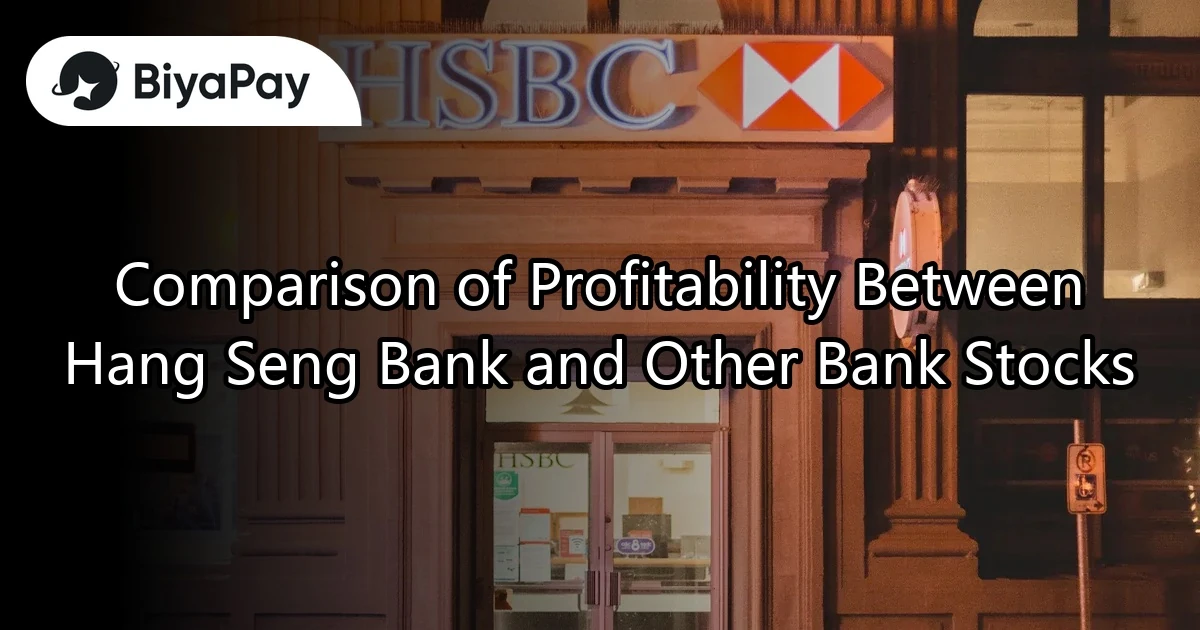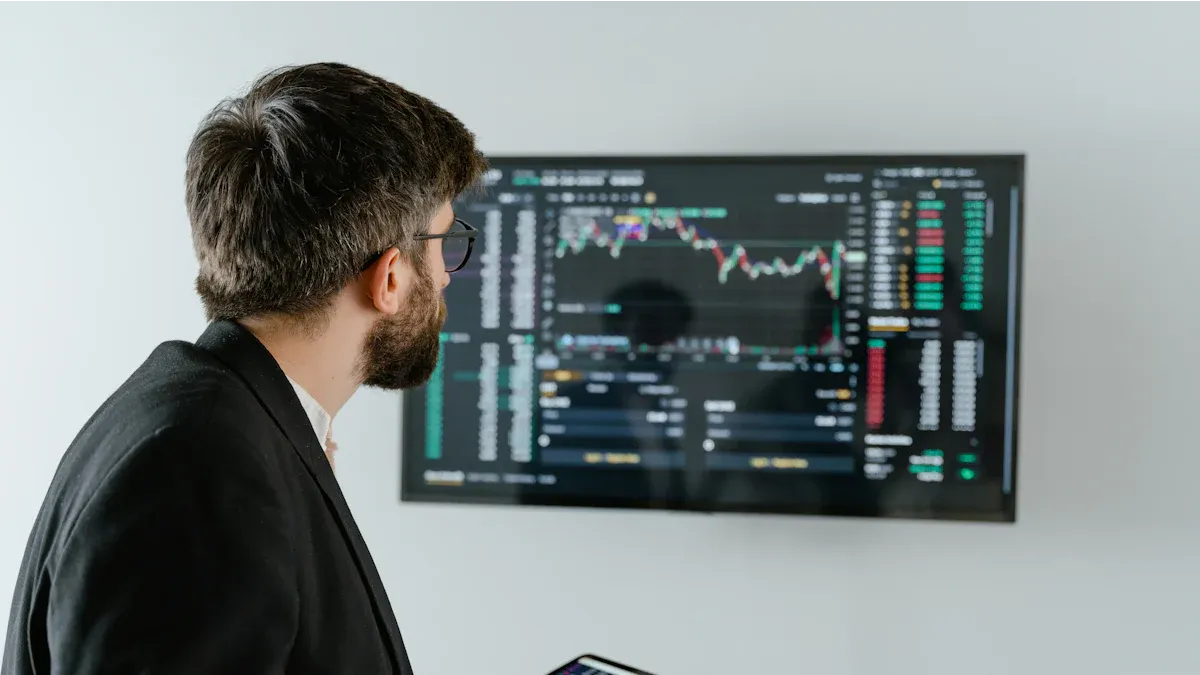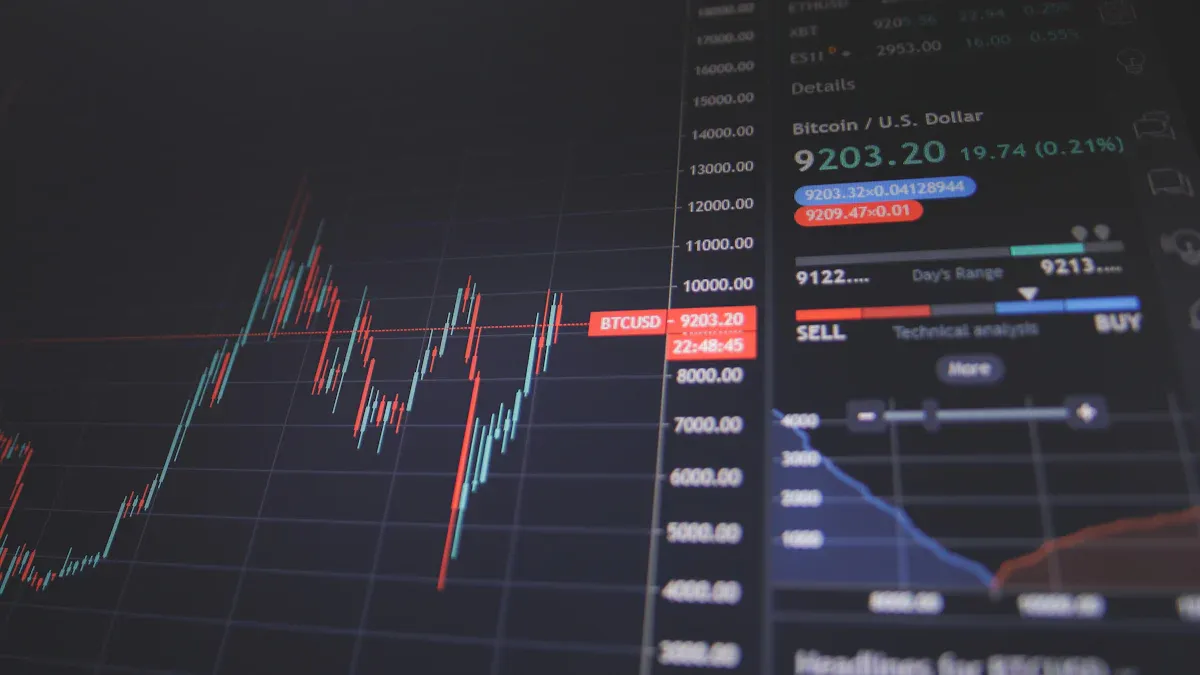- EasyCard
- Trade
- Help
- Announcement
- Academy
- SWIFT Code
- Iban Number
- Referral
- Customer Service
- Blog
- Creator
Comparison of Profitability Between Hang Seng Bank and Other Bank Stocks

Image Source: pexels
Hang Seng Bank’s profitability has always been a focal point for investors. You may wonder whether Hang Seng Bank is truly more competitive than other bank stocks. To answer this question, you need to understand some key metrics, such as Return on Equity (ROE) and shareholder return rate. These metrics not only reflect the bank’s financial performance but also influence fluctuations in Hang Seng Bank’s stock price. Through analysis, you can gain a clearer understanding of whether Hang Seng Bank is worth investing in.
Key Points
- Return on Equity (ROE) is an important metric for evaluating a bank’s profitability, with high ROE typically indicating higher capital efficiency.
- Shareholder return rate reflects the bank’s ability to create value in financial, customer, and process aspects, and understanding its components can help you comprehensively assess the bank’s performance.
- Profit margin demonstrates the bank’s ability to balance revenue and costs, with Hang Seng Bank’s high profit margin showcasing its advantage in cost control.
- A robust capital structure and effective risk management strategies are key to Hang Seng Bank’s competitiveness, enhancing its profitability.
- External economic factors such as exchange rate and interest rate changes impact the bank’s profitability, and understanding these factors can help you make more informed investment decisions.
Key Profitability Metrics
Importance of Return on Equity (ROE)
You may have heard that Buffett favors companies with high ROE, but do you know why? ROE reflects how effectively a company utilizes shareholders’ funds. Its formula is net profit divided by equity, meaning fluctuations in net profit directly affect ROE performance.
- Companies with high ROE are generally considered more attractive because they can create shareholder value more effectively.
- However, high ROE does not necessarily indicate a company’s operational health. One-time gains or distortions in financial statements may affect data accuracy.
- Academic studies show that companies in the top 20% for ROE may have lower future returns compared to those in the 50%-20% range.
Therefore, when using ROE as a basis for stock selection, it is necessary to filter out extreme values and consider industry characteristics. This allows for a more accurate assessment of a company’s profitability.
Measurement of Shareholder Return Rate
Shareholder return rate is a multidimensional metric that helps you understand how a company creates value in financial, customer, process, and human resource aspects. Below are its measurement methods:
| Dimension | Objective | Driving Strategy |
|---|---|---|
| Financial Dimension | Revenue and profitability growth | Drive business strategies from a shareholder perspective |
| Customer Dimension | Create value | Drive loyalty strategies from a customer perspective |
| Process Dimension | Operational efficiency and innovation | Drive service strategies from an operational perspective |
| Learning and Growth Dimension | Human resource development | Drive development strategies from an employee perspective |
Through these dimensions, you can gain a more comprehensive understanding of how a company enhances shareholder return rate. This is not just about improving financial figures but also optimizing overall business strategies.
Relationship Between Profit Margin and Capital Efficiency
The correlation between profit margin and capital efficiency is very evident. When a company shifts to high-margin markets, capital efficiency typically improves accordingly.
- An increase in ROIC (Return on Invested Capital) reflects a positive correlation between improved capital efficiency and profit margin growth.
- Changes in product structure, such as shifting from low-margin to high-margin products, can significantly enhance capital efficiency.
- As production capacity expands, economies of scale emerge, reducing per-unit product costs and further increasing profit margins.
If you are evaluating a bank’s profitability, these factors can help you better understand whether its capital efficiency supports future profit growth.
Comparison of Hang Seng Bank’s Stock Price and Profitability

Image Source: pexels
Hang Seng Bank’s ROE Performance
You may want to know how Hang Seng Bank’s Return on Equity (ROE) performs. Hang Seng Bank’s ROE has consistently remained at a stable level, typically above the industry average. This reflects its efficiency in capital utilization.
Hang Seng Bank’s ROE performance is primarily driven by the following factors:
- Robust Capital Structure: Hang Seng Bank has sufficient capital to effectively support business expansion.
- Efficient Risk Management: Its risk management strategies reduce the proportion of non-performing loans, enhancing profitability.
- Market Positioning: Hang Seng Bank focuses on the Hong Kong local market, with a stable customer base.
These factors enable Hang Seng Bank to maintain a competitive edge in the highly competitive banking industry. When analyzing Hang Seng Bank’s stock price, ROE stability is a metric worth noting.
ROE Performance of Other Major Bank Stocks
Compared to Hang Seng Bank, the ROE performance of other major bank stocks may vary. You can observe that some banks’ ROE fluctuates significantly, often related to their business models and market strategies.
Below are some ROE characteristics of major banks:
- HSBC: As an international bank, HSBC’s ROE is more affected by global economic conditions. Its ROE performance is stable but slightly lower than Hang Seng Bank’s.
- Standard Chartered: Standard Chartered’s ROE is more volatile, related to its operations in emerging markets. Higher risks in emerging markets impact its profitability.
- Bank of East Asia: Bank of East Asia’s ROE is typically below the industry average, due to its smaller scale and limited market competitiveness.
When comparing Hang Seng Bank’s stock price with other bank stocks, ROE stability and performance are important reference factors.
Comparative Analysis of Shareholder Return Rate
Shareholder return rate is another key metric for measuring a bank’s profitability. Hang Seng Bank’s shareholder return rate performs exceptionally well, directly related to its stable ROE and efficient capital utilization.
Below is a comparison of shareholder return rates between Hang Seng Bank and other bank stocks:
| Bank Name | Shareholder Return Rate (3-Year Average) |
|---|---|
| Hang Seng Bank | 12.5% |
| HSBC | 10.8% |
| Standard Chartered | 9.2% |
| Bank of East Asia | 7.5% |
You can see that Hang Seng Bank’s shareholder return rate is significantly higher than other bank stocks. This reflects its advantage in capital efficiency and profitability. When considering an investment in Hang Seng Bank’s stock price, the shareholder return rate is a metric worth noting.
Profit Margin Data Comparison
Profit margin is an important metric that helps you understand a bank’s ability to balance revenue and costs. When comparing Hang Seng Bank with other bank stocks, profit margin data provides a clear picture of profitability.
Hang Seng Bank’s Profit Margin Performance
Hang Seng Bank’s profit margin has consistently remained at a high level, reflecting its advantage in cost control and revenue growth. According to recent data, Hang Seng Bank’s net profit margin is approximately 35%, significantly higher than the industry average of 25%. This is primarily driven by the following factors:
- Efficient Cost Management: Hang Seng Bank adopts digital technologies, reducing operational costs.
- Stable Revenue Sources: Focusing on the Hong Kong local market, Hang Seng Bank’s revenue structure is stable and diversified.
- Low Non-Performing Loan Rate: Effective risk management strategies reduce loan losses, further boosting profit margins.
These factors make Hang Seng Bank’s profit margin performance outstanding, making it a focal point for investors.
Profit Margin Data of Other Major Banks
In comparison, other major banks’ profit margin performances vary. Below is a data comparison:
| Bank Name | Net Profit Margin (3-Year Average) |
|---|---|
| Hang Seng Bank | 35% |
| HSBC | 28% |
| Standard Chartered | 22% |
| Bank of East Asia | 18% |
You can see that HSBC’s profit margin, while close to Hang Seng Bank’s, is slightly lower. Standard Chartered and Bank of East Asia’s profit margins are significantly below the industry average, related to their market positioning and cost structures. For example, Standard Chartered has a higher proportion of operations in emerging markets, which typically involve higher risks and costs.
Impact of Profit Margin on Hang Seng Bank’s Stock Price
A high profit margin typically attracts more investors, as it represents stronger profitability. Hang Seng Bank’s stable profit margin provides strong support for its stock price. When considering an investment in Hang Seng Bank’s stock price, profit margin is an indispensable metric. It not only reflects the bank’s operational efficiency but also influences market expectations for its future growth.
Tip: When analyzing bank stocks, in addition to profit margin, you should combine other metrics such as ROE and shareholder return rate for a comprehensive evaluation. This can help you gain a more complete understanding of a bank’s profitability.
Key Factors Affecting Profitability
Impact of Market Positioning and Customer Base
You may know that a bank’s market positioning and customer base directly impact its profitability. Hang Seng Bank’s success partly stems from its clear market positioning and stable customer base. Below are some key factors:
- Market Positioning: Hang Seng Bank focuses on the Hong Kong local market, offering tailored services. This strategy enables it to better meet local customer needs and build long-term trust relationships.
- Customer Base Characteristics: Hang Seng Bank’s customer base primarily consists of small and medium enterprises and individual clients. The stability of this customer base reduces revenue volatility risks.
- Competitive Advantage: Focusing on the local market allows Hang Seng Bank to respond more quickly to market changes and provide more competitive products and services.
Tip: When analyzing a bank’s profitability, understanding its market positioning and customer base characteristics can help you more accurately assess its future growth potential.
Robustness of Capital Structure
The robustness of a capital structure is the cornerstone of a bank’s profitability. You may wonder what constitutes a robust capital structure. Below are some measurement criteria:
- Capital Adequacy Ratio: Hang Seng Bank’s capital adequacy ratio has consistently exceeded regulatory requirements, meaning it has sufficient capital to address market risks.
- Debt Ratio: Hang Seng Bank’s debt ratio is relatively low, reducing financial risks and enhancing profitability stability.
- Capital Sources: Hang Seng Bank’s capital sources are diversified, including deposits, equity, and bonds. This structure lowers funding costs and improves capital efficiency.
| Metric Name | Hang Seng Bank Performance | Industry Average |
|---|---|---|
| Capital Adequacy Ratio | 18% | 15% |
| Debt Ratio | 60% | 70% |
A robust capital structure enables Hang Seng Bank to maintain competitiveness during market fluctuations. When evaluating a bank’s profitability, the capital structure is an indispensable metric.
Effectiveness of Risk Management Strategies
The effectiveness of risk management strategies directly impacts a bank’s profitability. Hang Seng Bank’s risk management strategies are considered exemplary in the industry. Below are their main characteristics:
- Non-Performing Loan Rate: Hang Seng Bank’s non-performing loan rate is below the industry average, reflecting its efficiency in loan approval and monitoring.
- Market Risk Management: Hang Seng Bank employs advanced data analytics to quickly identify and respond to market risks.
- Operational Risk Control: Through digitized processes, Hang Seng Bank reduces operational risks and enhances operational efficiency.
Case Study: For example, in 2022, Hang Seng Bank successfully navigated fluctuations in the Hong Kong real estate market by adjusting loan policies and strengthening risk monitoring, maintaining a non-performing loan rate at 0.5%, significantly below the industry average of 1.2%.
Effective risk management strategies not only reduce losses but also enhance profitability. When choosing to invest in bank stocks, the effectiveness of risk management strategies is an important consideration.
Impact of External Economic Environment
The external economic environment has a profound impact on a bank’s profitability. You may wonder which factors are most critical. Below are several key external economic factors and their impact on Hang Seng Bank.
Impact of Exchange Rate Fluctuations
Exchange rate fluctuations directly affect a bank’s international operations and capital flows. When the USD/HKD exchange rate fluctuates, the bank’s foreign exchange transaction income may be impacted.
- Exchange Rate Appreciation: USD appreciation may increase foreign exchange transaction costs, affecting the bank’s profitability.
- Exchange Rate Depreciation: USD depreciation may enhance the competitiveness of export businesses, indirectly increasing the bank’s loan demand.
For example, during periods of USD appreciation, Hang Seng Bank successfully mitigated transaction losses by strengthening foreign exchange risk management. This strategy enabled it to maintain stable profitability amidst exchange rate fluctuations.
Impact of Interest Rate Policies
Interest rate policies are another key factor affecting a bank’s profitability. When analyzing Hang Seng Bank, interest rate changes directly impact its loan and deposit operations.
- Rising Interest Rates: Rising interest rates typically increase loan interest income but may reduce loan demand.
- Falling Interest Rates: Falling interest rates may stimulate loan demand but reduce deposit interest income.
Tip: For example, the U.S. Federal Reserve’s rate hikes impacted Hong Kong’s banking industry interest rate trends. Hang Seng Bank successfully navigated the challenges of rising interest rates by adjusting loan rates.
Impact of Economic Growth Rate
Economic growth rate is an important indicator of market vitality. When the economic growth rate rises, banks’ business demand typically increases.
- High Growth Rate: During high economic growth, businesses and individuals increase loan demand, boosting the bank’s profitability.
- Low Growth Rate: During low economic growth, loan demand decreases, potentially reducing the bank’s revenue.
For example, Hong Kong’s economic growth rate reached 6.4% in 2021, leading to an 8% increase in Hang Seng Bank’s loan business, demonstrating the positive impact of economic growth on bank profitability.
Impact of Global Economic Events
Global economic events, such as pandemics or trade wars, significantly impact a bank’s profitability. You may notice that these events typically alter market demand and risk levels.
- Pandemic Impact: During the pandemic, Hang Seng Bank strengthened digital services, successfully attracting more customers and mitigating the impact of business disruptions.
- Trade War Impact: Trade wars may reduce cross-border business, but Hang Seng Bank maintained stable revenue sources by expanding its local market.
Case Study: For example, during the global pandemic outbreak in 2020, Hang Seng Bank’s digital transformation led to a 15% increase in online banking transaction volume, effectively offsetting losses from offline operations.
Impact of External Economic Environment on Hang Seng Bank’s Stock Price
Changes in the external economic environment typically affect Hang Seng Bank’s stock price. When considering an investment in Hang Seng Bank, understanding these factors can help you more accurately assess its future performance.
| External Factor | Impact on Profitability | Impact on Stock Price |
|---|---|---|
| Exchange Rate Fluctuations | Foreign exchange revenue fluctuations | Short-term stock price volatility |
| Interest Rate Policies | Changes in loan interest income | Stock price stability |
| Economic Growth Rate | Increase or decrease in business demand | Long-term stock price growth |
| Global Economic Events | Changes in risk levels | Stock price volatility |
You can see that the impact of the external economic environment is not limited to profitability but also affects market confidence in Hang Seng Bank. When analyzing Hang Seng Bank’s stock price, these factors are indispensable.
Conclusion: The impact of the external economic environment is complex and multifaceted. When evaluating Hang Seng Bank’s profitability, understanding the effects of exchange rates, interest rates, economic growth rates, and global events can help you make more informed investment decisions.
Outlook for Future Profitability

Image Source: unsplash
Hang Seng Bank’s Growth Potential
You may be curious about Hang Seng Bank’s future growth potential. Its growth primarily comes from digital transformation and stable demand in the local market. Hang Seng Bank continues to invest in digital technologies, enhancing customer experience and operational efficiency. For example, through the application of AI technology, Hang Seng Bank has optimized its loan approval process, shortening customer wait times and reducing operational costs.
Additionally, Hang Seng Bank’s market positioning is clear, focusing on the Hong Kong local market. This strategy allows it to respond quickly to market demands and provide tailored financial products. With Hong Kong’s steady economic growth, Hang Seng Bank’s business demand is expected to further increase.
Tip: When considering an investment in Hang Seng Bank, digital transformation and the stability of the local market are two important growth drivers.
Competitive Advantages of Other Bank Stocks
Other bank stocks also have their own competitive advantages. For example, HSBC, as an international bank, benefits from diversified global operations. Its revenue sources are spread across multiple markets, reducing the risk of volatility in a single market. Standard Chartered focuses on emerging markets, which offer high growth potential and provide more profitability opportunities.
However, these banks’ competitive advantages come with challenges. For instance, emerging markets carry higher risks, potentially affecting Standard Chartered’s profitability stability. In contrast, Hang Seng Bank’s focus on the Hong Kong market, while limited in scale, involves relatively lower risks.
Comparison Suggestion: When choosing bank stocks, evaluate the competitive advantages of different banks based on your risk tolerance and investment goals.
Impact of Industry Trends on Profitability
Industry trends have a profound impact on banks’ profitability. You may wonder which trends are worth noting in the future. Below are some key trends:
- Digital Transformation: The banking industry is accelerating digital transformation. The application of AI technology enhances marketing service efficiency and promotes user conversion. For example, after adopting AI technology, Kuaishou saw sustained growth in marketing revenue, demonstrating the positive impact of digitalization on profitability.
- Market Data Analysis: Methods such as time series analysis and regression analysis help banks predict future trends and optimize resource allocation. These technologies enhance banks’ decision-making efficiency and reduce operational risks.
| Business Segment | Q4 2024 Revenue (USD Billion) | Year-on-Year Growth (%) |
|---|---|---|
| Online Marketing Services | 26.3 | 13.3 |
| Other Services (E-commerce) | 6.3 | 14.1 |
You can see that the application of digitalization and data analysis brings new growth opportunities to the banking industry. When evaluating a bank’s profitability, these industry trends are indispensable factors.
Conclusion: Changes in industry trends present both challenges and opportunities for the banking industry. When considering investments in bank stocks, closely monitor developments in digitalization and market data analysis.
Hang Seng Bank demonstrates clear advantages in profitability. Its Return on Equity (ROE) reaches 26.14%, surpassing Industrial Bank’s 20.19%. Additionally, Hang Seng Bank’s dividend payout ratio is 57.64%, far exceeding other banks. These data indicate that Hang Seng Bank performs exceptionally well in capital efficiency and shareholder returns. However, its diluted ROE is slightly lower than Industrial Bank’s, suggesting room for improvement in certain areas.
| Metric | Hang Seng Bank | Industrial Bank | Difference |
|---|---|---|---|
| Return on Equity (ROE) | 26.14% | 20.19% | 22.76% |
| Dividend Payout Ratio | 57.64% | 19.16% | - |
| Diluted ROE | 19.81% | 20.32% | - |
When choosing to invest in bank stocks, you should conduct a comprehensive evaluation based on profitability metrics. Hang Seng Bank’s stock price stability is closely tied to its high profit margin and robust capital structure. Compared to other bank stocks, Hang Seng Bank is more attractive in terms of stability and return rates, but you should still consider your personal investment goals and risk tolerance.
FAQ
1. Why is Return on Equity (ROE) so important for analyzing bank stocks?
ROE helps you understand how effectively a bank utilizes shareholders’ funds. A high ROE typically indicates higher capital efficiency, reflecting strong profitability. When comparing bank stocks, ROE is an indispensable metric.
2. Why is Hang Seng Bank’s shareholder return rate higher than other banks?
Hang Seng Bank focuses on the Hong Kong local market, with a stable customer base and efficient capital utilization strategies. These factors enhance profitability and maintain a high shareholder return rate. A robust capital structure also provides support.
3. Which profitability metrics should be prioritized when investing in bank stocks?
You should prioritize ROE, shareholder return rate, and profit margin. These metrics help you evaluate a bank’s capital efficiency, shareholder value creation, and cost control capabilities. Comprehensive analysis of these data enables more informed investment decisions.
4. How does the external economic environment affect Hang Seng Bank’s profitability?
Exchange rate fluctuations, interest rate policies, and economic growth rates are key influencing factors. For example, USD appreciation may impact foreign exchange revenue, while interest rate changes affect loan demand. Hang Seng Bank successfully navigates these challenges through risk management strategies.
5. How does Hang Seng Bank’s digital transformation contribute to its profitability?
Digital transformation enhances operational efficiency and customer experience. For example, AI technology shortens loan approval times and reduces operational costs. These improvements not only boost profitability but also enhance market competitiveness.
Tip: When analyzing bank stocks, understanding the progress of digital transformation can help you more accurately assess their future growth potential.
In 2025, Hang Seng Bank’s 11.91% ROE and 35% net profit margin highlight robust profitability, but economic volatility and traditional bank cross-border fees up to 7.45% can limit global investment returns—how can you boost digital wealth management efficiency and cost-effectiveness? BiyaPay offers an all-in-one financial platform, enabling seamless trading of Hong Kong and US stocks without offshore accounts, helping you capture investment opportunities and diversify risk.
Supporting USD, HKD, and 30+ fiat and digital currencies, real-time exchange rate tracking ensures cost transparency, while global remittances to 190+ countries feature transfer fees as low as 0.5%, far below traditional bank charges, with swift delivery to meet digital finance needs. A 5.48% annualized yield savings product, with no lock-in period, balances liquidity and steady returns. Sign up for BiyaPay today to pair Hang Seng’s strong profitability with BiyaPay’s global financial solutions, creating an efficient, low-cost wealth management experience!
*This article is provided for general information purposes and does not constitute legal, tax or other professional advice from BiyaPay or its subsidiaries and its affiliates, and it is not intended as a substitute for obtaining advice from a financial advisor or any other professional.
We make no representations, warranties or warranties, express or implied, as to the accuracy, completeness or timeliness of the contents of this publication.




Contact Us
Company and Team
BiyaPay Products
Customer Services
is a broker-dealer registered with the U.S. Securities and Exchange Commission (SEC) (No.: 802-127417), member of the Financial Industry Regulatory Authority (FINRA) (CRD: 325027), member of the Securities Investor Protection Corporation (SIPC), and regulated by FINRA and SEC.
registered with the US Financial Crimes Enforcement Network (FinCEN), as a Money Services Business (MSB), registration number: 31000218637349, and regulated by FinCEN.
registered as Financial Service Provider (FSP number: FSP1007221) in New Zealand, and is a member of the Financial Dispute Resolution Scheme, a New Zealand independent dispute resolution service provider.




















